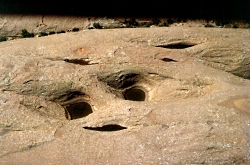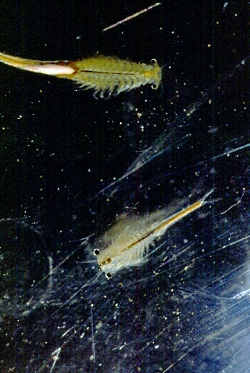
Photo Courtesy USGS
 Adult fairy shrimp
Adult fairy shrimp
Branchinecta packardi.
Photo Courtesy USGS
 Adult Vernal Pool Fairy Shrimp
Adult Vernal Pool Fairy Shrimp
Branchinecta lynchi
Photo Courtesy USGS
Shrimp in the desert landscape of Canyonlands National Park? Yep. You can find them, –fairy shrimp– when the rainy season arrives and turns dry, dusty potholes into water-filled rock basins brimming with life.
A surprising array of creatures relies on these potholes for life, and one of the most curious is the fairy shrimp. These unique crustaceans are found in small potholes that dot sandstone outcrops found in America’s Southwest. Their eggs maintain resilience during the dry season, and when spring rains arrive, the shrimp hatch.
There are more than 300 varieties of fairy shrimp, the most common being the Vernal Pool Fairy Shrimp. These little guys measure between a half-inch to one-and-a-half inches long as adults. They can be found anywhere ephemeral pools are present, though the majority of their population resides in California and Oregon.
Fairy shrimp vary in color depending on the menu found in their particular pool of residency, ranging from translucent, to orange, even to blue! They feature 11 pairs of legs to propel themselves upside-down, or more scientifically, ventral side-up.
They also use these incredibly helpful legs to eat unicellular algae, ciliates (sil-ee-its), and bacteria by filter and suspension feeding methods. They filter-feed by pumping water through filtration structures — located in their multi-purpose legs — thus capturing the food. They also are adept at suspension feeding by plucking food floating in the water, again, with their tentacle-like legs. They may also grab or scrape food from the surfaces of other things in their vernal pool, such as sticks and rocks.
What’s truly amazing is how fairy shrimp reproduce. They typically lay drought-tolerant eggs during the summer that over-winter in the dried sediment on the pot hole bottom and then hatch in the spring when the potholes fill with rainwater However, if drought sets in, eggs can be transferred to other pools by floating in gusts of wind or being carried by a particularly curious animal.
These eggs are tough and can withstand varying temperatures, drought, and even the test of time; eggs in laboratory settings have survived intact up to 15 years before hatching.
Under the right conditions, you can observe fairy shrimp in Canyonlands, Arches, and Death Valley national parks. Canyonlands and Arches boast at least two species of fairy shrimp: the Packard Ferry Shrimp, also known as the Rock Pool Ferry Shrimp or the Arizona Ferry Shrimp, and the Great Plains Ferry Shrimp.
Fairy shrimp hatch in the Spring, right after the potholes and vernal pools re-fill with water, so that will be your prime time to look for these interesting creatures. As travelers, you can do your part to help the fairy shrimp by leaving their vernal pools alone. Drinking water, stepping in, or touching a pool can throw off the entire mini-eco-system located in this fascinating habitat.
And remember, our fingers are very salty, so even if you’re using a gentle touch, do not put your fingers in a vernal pool, as it just might raise the salinity and throw off the dissolved oxygen percentage needed for fairy shrimp to survive.
For Wild About Utah and National Parks Traveler, I’m Kurt Repanshek.
Credits:
Image: Courtesy and Copyright Kurt Repanshek, www.nationalparkstraveler.com
Text: Kurt Repanshek, NationalParksTraveler.com.
Additional Reading:
https://digitallibrary.utah.gov/awweb/awarchive?type=file&item=22782
https://www.nwf.org/wildlife/wildlife-library/invertebrates/vernal-pool-fairy-shrimp.aspx
https://www.arizonafairyshrimp.com/fairyshrimp.html
https://geochange.er.usgs.gov/sw/impacts/biology/vernal/
https://www.nasa.gov/centers/dryden/news/X-Press/shrimp_spotlight.html
https://www.fws.gov/sacramento/es_kids/Vernal-Pool-Fairy-Shrimp/es_kids_vernal-pool-fairy-shrimp.htm
